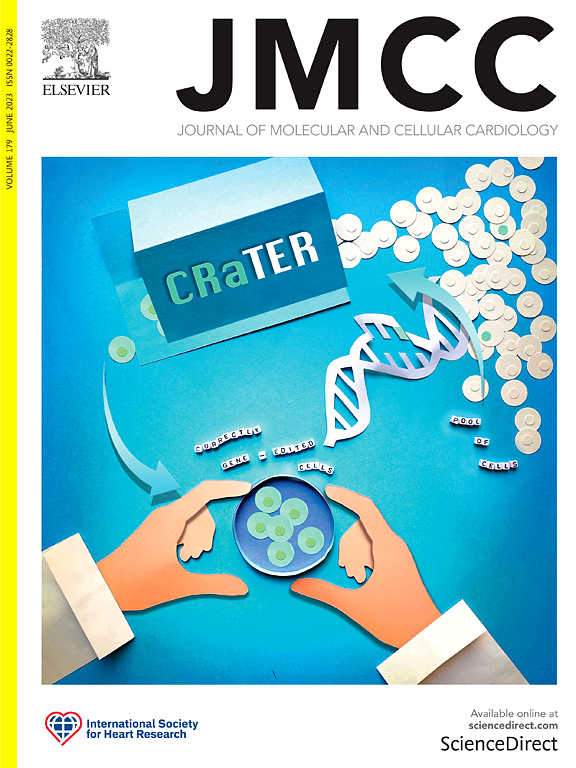Generation of a novel constitutive smooth muscle cell-specific Myh11-driven Cre mouse model
IF 4.7
2区 医学
Q1 CARDIAC & CARDIOVASCULAR SYSTEMS
引用次数: 0
Abstract
Dysfunction in either embryonic or postnatal smooth muscle cells (SMCs) significantly contributes to the progression of various cardiovascular and visceral diseases. Therefore, elucidating the molecular mechanisms governing SMC development and homeostasis is crucial. MYH11 is the most reliable lineage gene for SMCs and has been utilized to develop tamoxifen-inducible Cre driver lines for achieving SMC-specific gene manipulation by crossing with mice carrying the loxP-flanked gene, particularly in adult mice. For studies involving SMCs during embryogenesis, the commonly used constitutive Cre driver is controlled by the Tagln (also known as SM22α) promoter. However, this Cre driver exhibits activity in multiple non-SMC populations, including cardiomyocytes and skeletal muscle precursors, introducing confounding effects. Additionally, most existing SMC-specific Cre drivers are generated using a transgenic approach, raising concerns about random site integration and variable gene copy numbers. To address these limitations, we report a novel Cre mouse model generated by knock-in (KI) of a nuclear-localized Cre recombinase into the Myh11 gene locus using homologous recombination. We confirmed that the Cre activity precisely recapitulates endogenous Myh11 expression by crossing with Rosa26 mTmG or tdTomato reporter mice. Moreover, Myh11-driven Cre can efficiently delete the floxed allele of the transcription factor Tead1 specifically in SMCs. The Tead1 SMC-specific knockout mice did not exhibit an overt phenotype, thereby circumventing the embryonic lethal phenotype mediated by Tagln-driven Cre, as we previously reported. These findings establish this novel Cre driver line as a robust tool for tracing the Myh11-positive SMC lineage and manipulating gene function specifically in SMCs during embryonic development in both male and female mice.

生成一种新的结构平滑肌细胞特异性myh11驱动的Cre小鼠模型。
胚胎或出生后平滑肌细胞(SMCs)功能障碍对各种心血管和内脏疾病的进展有重要影响。因此,阐明控制SMC发育和稳态的分子机制至关重要。MYH11是SMCs最可靠的谱系基因,已被用于开发他莫昔芬诱导的Cre驱动系,通过与携带loxp侧基因的小鼠(特别是成年小鼠)杂交,实现SMCs特异性基因操作。在涉及胚胎发生过程中SMCs的研究中,常用的组成型Cre驱动由Tagln(也称为SM22α)启动子控制。然而,这种Cre驱动在多种非smc人群中表现出活性,包括心肌细胞和骨骼肌前体,引入混淆效应。此外,大多数现有的smc特异性Cre驱动程序是使用转基因方法生成的,这引起了对随机位点整合和可变基因拷贝数的担忧。为了解决这些局限性,我们报道了一种新的Cre小鼠模型,该模型是通过同源重组将核定位的Cre重组酶敲入Myh11基因位点而产生的。通过与Rosa26 mTmG或tdTomato报告小鼠杂交,我们证实了Cre的活性精确地再现了内源性Myh11的表达。此外,myh11驱动的Cre可以在SMCs中特异性地有效地删除转录因子Tead1的floxed等位基因。正如我们之前报道的那样,Tead1 smc特异性敲除小鼠没有表现出明显的表型,从而规避了由tagln驱动的Cre介导的胚胎致死表型。这些发现确立了这种新的Cre驱动系作为追踪myh11阳性SMC谱系和在小鼠胚胎发育过程中特异性操纵SMC基因功能的强大工具。
本文章由计算机程序翻译,如有差异,请以英文原文为准。
求助全文
约1分钟内获得全文
求助全文
来源期刊
CiteScore
10.70
自引率
0.00%
发文量
171
审稿时长
42 days
期刊介绍:
The Journal of Molecular and Cellular Cardiology publishes work advancing knowledge of the mechanisms responsible for both normal and diseased cardiovascular function. To this end papers are published in all relevant areas. These include (but are not limited to): structural biology; genetics; proteomics; morphology; stem cells; molecular biology; metabolism; biophysics; bioengineering; computational modeling and systems analysis; electrophysiology; pharmacology and physiology. Papers are encouraged with both basic and translational approaches. The journal is directed not only to basic scientists but also to clinical cardiologists who wish to follow the rapidly advancing frontiers of basic knowledge of the heart and circulation.

 求助内容:
求助内容: 应助结果提醒方式:
应助结果提醒方式:


